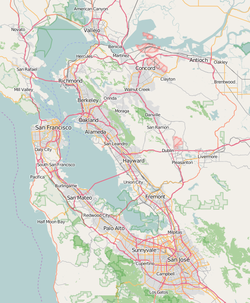Richmond Transport tunnel
In this article, we want to delve into the topic of Richmond Transport tunnel and explore all its dimensions. Richmond Transport tunnel has been a topic of constant interest throughout history, with multiple approaches and analyzes from different disciplines. From its origins to the present, Richmond Transport tunnel has played a crucial role in people's lives and the development of society. In this article, we aim to examine Richmond Transport tunnel from different perspectives, analyzing its impact on culture, politics, science, the arts, and everyday life. We hope this article serves as a comprehensive guide to understanding the importance and relevance of Richmond Transport tunnel in the modern world.
| Overview | |
|---|---|
| Other name(s) | El Camino Del Mar tunnel |
| Coordinates | 37°47′16″N 122°29′00″W / 37.787654°N 122.483369°W (east portal) |
| Status | Active |
| Operation | |
| Opened | December 7, 1995 (construction) August 1995 (operation)[1] |
| Character | combined sewer tunnel |
| Technical | |
| Length | 10,200 feet (3,100 m) long |
| Tunnel clearance | 14 feet (4.3 m) diameter |
The Richmond Transport tunnel is a 10,200-foot-long (3,100 m), 14-foot diameter (4.3 m) combined sewer transport and storage tunnel in San Francisco, California. The tunnel travels from its east portal in the Sea Cliff neighborhood westward under Lincoln Park and Lands End then southward to the north point of the Great Highway.[2]
History
The tunnel was constructed in 1995 as part of San Francisco's Wastewater Master Plan. It serves both as sewage transport and as storage with a capacity of 10,000,000 US gallons (38,000 m3). As part of the Richmond transport project, the tunnel connects to the previously abandoned Mile Rock Tunnel outfall and uses it as an emergency overflow when capacity is exceeded.[2]
In December 1995, state Senator Quentin Kopp and Lincoln Park Neighborhood Association president Jake Murdock blamed the tunnel construction for a nearby sewer line collapse and subsequent sinkhole.[3] The engineering consulting firm Exponent hired by the city found that "cracks in the sewer developed when a series of events converged, including constriction of stormwater flow in pipes and construction activities around the sewers."[4][5]
References
- ^ Brazil, Eric (1995-12-08). "Massive tunnel opens". SFGate. Retrieved 2025-02-19.
- ^ a b Maiolini, Steven; Klein, Steve; Essex, Randy (January 1995). "Policies influencing the design of the Richmond transport project" (PDF). Tunnelling and Underground Space Technology - TUNN UNDERGR SPACE TECHNOL. 10: 37–44. doi:10.1016/0886-7798(94)00063-Q. Retrieved 2025-02-05.
- ^ Nolte, Carl (1995-12-12). "Sea Cliff Mansion Tumbles Into Hole / Aged sewer line collapses under home". SFGate. Retrieved 2025-02-05.
- ^ Smith, Kendra (2024-12-21). "An empty lot still sits where a sinkhole swallowed a San Francisco home". SFGate. Retrieved 2025-02-05.
- ^ "Well-Known Investigations". Exponent. Exponent, Inc. Retrieved 2025-02-05.


